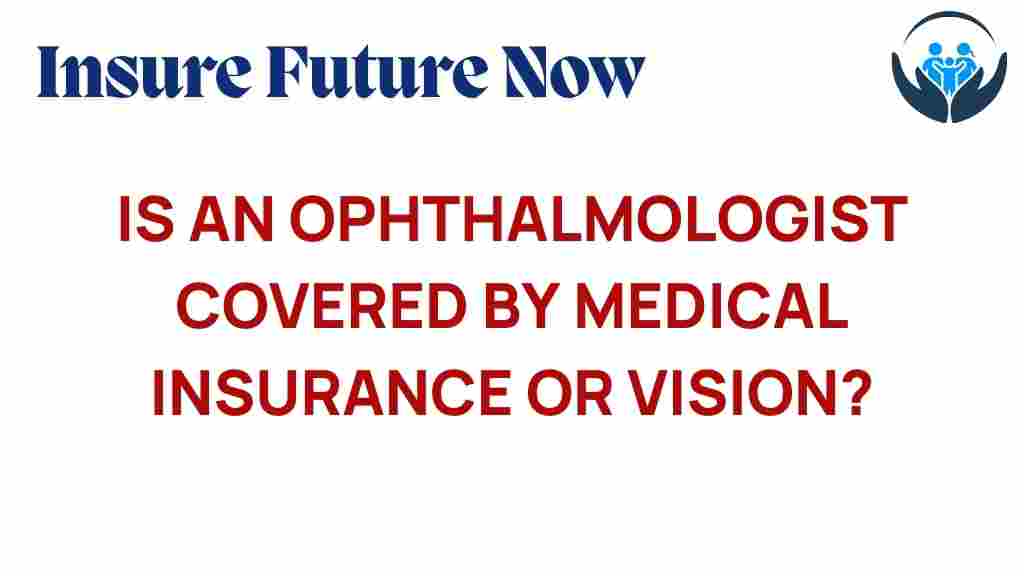When it comes to maintaining our health, understanding our insurance coverage is paramount, especially when it involves specialized care such as that provided by an ophthalmologist. As eye care professionals, ophthalmologists play a crucial role in diagnosing and treating a range of eye conditions, but many patients often wonder whether their medical insurance or vision insurance covers these essential services. This article aims to clarify how to navigate your healthcare coverage to determine if an ophthalmologist is included in your insurance policy.
Understanding Your Insurance Policies
Before diving into whether an ophthalmologist is covered, it’s essential to understand the different types of insurance policies that may apply to eye care:
- Medical Insurance: Typically covers necessary medical treatments and procedures, including surgery and consultations with specialists like ophthalmologists.
- Vision Insurance: Often focuses on routine eye exams, glasses, and contact lenses. This type of insurance may provide limited coverage for eye diseases.
Knowing the distinction between these two types of coverage can help you make informed decisions about your eye care.
Step-by-Step Process to Check Your Coverage
To determine if your insurance covers visits to an ophthalmologist, follow these steps:
1. Review Your Insurance Policy
Begin by reviewing the details of your insurance policy. Look for sections that outline coverage for:
- Specialist visits
- Preventive care
- Eye care services
2. Check for Referrals
If you have a Health Maintenance Organization (HMO), you might need a referral from your primary care physician to see an ophthalmologist. Make sure to get this referral if required.
3. Contact Your Insurance Provider
Reach out to your insurance company for clarification. Ask specific questions such as:
- Is an ophthalmologist covered under my plan?
- What services are covered?
- Are there any co-pays or deductibles?
4. Verify with the Ophthalmologist’s Office
Before your appointment, confirm that the ophthalmologist accepts your insurance. They often have staff dedicated to verifying insurance benefits and can provide insight into your coverage.
5. Understand Your Vision Benefits
If you have separate vision insurance, review the benefits it offers. This may include:
- Annual eye exams
- Discounts on lenses and frames
- Coverage for specific treatments or procedures
Common Eye Care Services Covered
Here are some of the common services provided by ophthalmologists that may be covered by medical insurance:
- Comprehensive eye exams
- Diagnosis and treatment of eye diseases such as glaucoma and cataracts
- Eye surgery, including LASIK and cataract surgery
- Management of chronic eye conditions
Vision insurance, on the other hand, typically covers routine eye exams and may provide allowances for glasses and contact lenses.
Patient Rights Regarding Insurance Coverage
As a patient, it’s essential to know your rights concerning healthcare coverage:
- Right to Information: You have the right to receive clear information about your insurance benefits and coverage limitations.
- Right to Appeal: If a claim is denied, you have the right to appeal the decision and request a review.
- Right to Choose: You can choose your healthcare provider, within the constraints of your insurance plan.
Understanding these rights can empower you when navigating the complexities of insurance policies.
Troubleshooting Tips for Coverage Issues
If you encounter issues with your insurance coverage for ophthalmology services, here are some troubleshooting tips:
1. Document Everything
Keep detailed records of all communications with your insurance provider and the ophthalmologist’s office. This includes dates, names of representatives, and the content of the conversations.
2. Request a Written Explanation
If a claim is denied, ask for a written explanation of the denial. This documentation can be crucial for appeals.
3. Know the Claims Process
Familiarize yourself with the claims process outlined in your insurance policy. Understanding how claims should be submitted can prevent delays.
4. Seek Assistance from Advocacy Groups
If you feel overwhelmed, consider reaching out to patient advocacy groups that specialize in healthcare coverage. They can provide guidance and support.
Conclusion
Navigating insurance coverage for eye care can be daunting, but understanding your options is vital. Whether you have medical insurance or vision insurance, knowing what is covered, and your rights as a patient can lead to better eye health outcomes. Always take the time to review your insurance policies, contact your provider, and verify details with your ophthalmologist’s office. By being proactive, you can ensure that you receive the necessary care without unexpected costs.
For more information on healthcare coverage and insurance policies, consider visiting Healthcare.gov. You can also explore other helpful resources on eye care and insurance options by clicking here.
Understanding your coverage and knowing your rights will empower you as a patient, allowing you to prioritize your eye health confidently.
This article is in the category Coverage and created by InsureFutureNow Team
